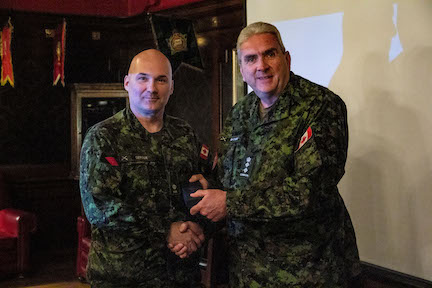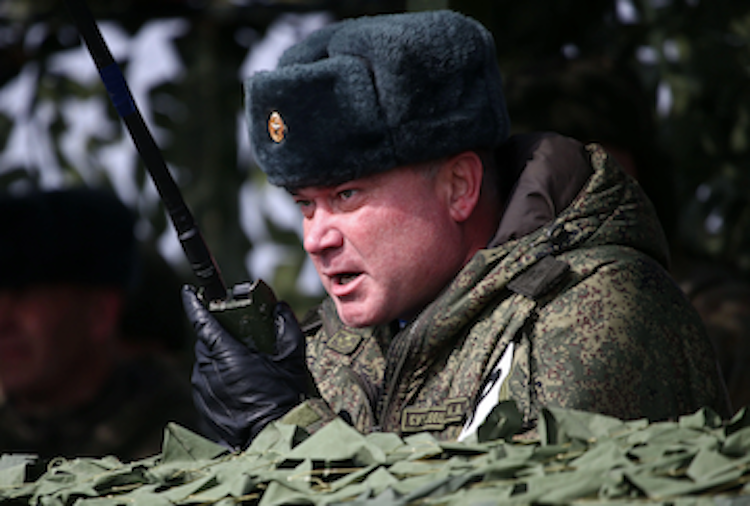Urban Operations in the Russo-Ukraine War: Part One
Argyll Regimental Foundation Speakers Series Featuring Maj Jayson Geroux

Maj Geroux receiving a gift of appreciation from Honorary Colonel Glenn DeCaire.
In April 2023, the Argyll Regimental Foundation sponsored a guest speaker to talk on the lessons to be learned from the ongoing Russo-Ukraine War. Major Jayson Geroux addressed an audience of serving members and friends of the Regiment in the Officers’ Mess. The audience was in rapt attention throughout as Maj Geroux briefed the room. I will try to paraphrase his presentation in a series of three posts due to the large size of each section. – LCol (ret) Tom Compton, CD, BA, Director, Argyll Regimental Museum & Archives
Maj Geroux’s main teaching points included:
Russian Urban Operations Doctrine;
Russian Urban Operations History;
The opening days of the war in Ukraine; and
Other urban warfare battles.
Common Reasons for Urban Operations:
Military reasons such as the enemy being present in a city, logistics hubs, a city may be within or on the way to an objective;
Political reasons;
A combination of both; and
Geographic reasons
Russian Doctrine
Artillery is the primary combat arm. Infantry and armour are considered subordinate.
The Russians prefer to attack an urban area “off the line of march,” similar to a quick attack.
If the “off the line of march” approach is unsuccessful, they will revert to a combined arms approach or a deliberate attack.
Russian Methodology
Isolation of the city;
Break in;
Block by block clearance;
Clear remaining pockets; and
Reorganize and consolidate.
 Image 1. Most Russian battles, extending back to the Second World War, have historically been from “off the Line of March,” including Stalingrad 1942-1943; Kabul 1979; Berlin 1945; and Grozny (x3).
Image 1. Most Russian battles, extending back to the Second World War, have historically been from “off the Line of March,” including Stalingrad 1942-1943; Kabul 1979; Berlin 1945; and Grozny (x3).
 Image 2. The Russian multiple axes of advance into Ukraine, February-March, 2022. (Open source: Published by UK Defence Intelligence, 29 March 2022)
Image 2. The Russian multiple axes of advance into Ukraine, February-March, 2022. (Open source: Published by UK Defence Intelligence, 29 March 2022)
The Ukrainians considered a variety of courses of action to be taken by the Russians, but in the end, Image 2 illustrates the multiple axes of advance used by Russian forces. This was, and still is, problematic for the Russian forces as they had far too few forces to properly sustain each of the axes of advance.
Kyiv, 27 February 2022
The Russians decided to attack off the line of march using airborne and mechanized forces to seize Hostomel and Boryspil airports just outside Kyiv, and to drive south from the international border. The Russians failed to isolate the city and advanced on three routes, but the battles at each airport went badly as the Ukrainians anticipated their moves. In addition, the Ukrainians blew bridges and flooded areas in the city to restrict Russian movement. These actions channelled the Russians onto narrow routes, where they were destroyed on the line of march. Maj Gen A. Sukhovetsky was killed in action during the assault on Kyiv because, in keeping with the top-down approach of Russian leadership, he was far too forward and exposed himself. Russian communications were notoriously poor at this stage in the war, and use of unsecured cellphones and commercial radios was common, leading to security breaches and the targeting of senior Russian officers.
 Image 3. Bridge blown by Ukrainian Sappers. (Public domain)
Image 3. Bridge blown by Ukrainian Sappers. (Public domain)
 Image 4. Russian forces destroyed on the road from Hostomel Airport. (Public domain)
Image 4. Russian forces destroyed on the road from Hostomel Airport. (Public domain)
 Image 5. Russian forces destroyed on the road from Hostomel Airport. (Public domain)
Image 5. Russian forces destroyed on the road from Hostomel Airport. (Public domain)
 Image 5A. Major General Andrei Sukhovetsky, killed in action during the attack on Kyiv. (Public domain)
Image 5A. Major General Andrei Sukhovetsky, killed in action during the attack on Kyiv. (Public domain)
Kharkiv, 27 February, 2022
In a very similar situation to that in Kyiv, the Russians tried to attack off the line of march using three routes into the city. Again, they had insufficient forces, failed to isolate the city, and were picked off as they tried to advance without a properly planned combined arms approach.
 Image 6. Relatively lightly armoured forces tried to drive into the city but were picked off and defeated by Ukrainian infantry using anti-armour weapons. A failure to isolate the city and to use a combined arms approach left the Russian forces vulnerable. (Public domain)
Image 6. Relatively lightly armoured forces tried to drive into the city but were picked off and defeated by Ukrainian infantry using anti-armour weapons. A failure to isolate the city and to use a combined arms approach left the Russian forces vulnerable. (Public domain)